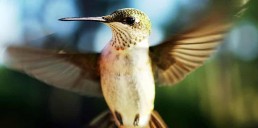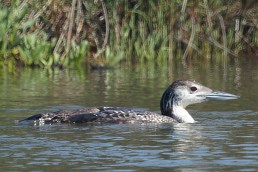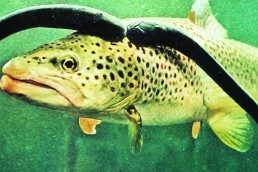Hummingbirds: Bumblebees on Steroids
SHARE THIS POST
While living off the land, I’ve “communed with nature” to a relatively unique degree, but one of my most memorable experiences was when I held a hummingbird in my hand. It weighed no more than a pile of feathers and its heartbeat was as rapid as the low hum during a Gregorian chant.
The hummingbird had ventured into my ramshackle dwelling and was frantically trying to escape. As soon as I had it in hand, it seemed to settle down. It may have been frozen with fear, but I don’t think completely. It didn’t “play possum” and continued to move its head to study me.
The only other creatures I’ve captured that felt as delicate were mayflies. I held one with the same softness, exerting the slightest touch to its wings with my thumb and middle finger to keep it from flying until I could get it outside.
I realized at this moment I had been blessed with a singular experience—on a par with spotting a timber wolf in the Quetico Wilderness and a mountain lion in the Devil’s Backbone Wilderness. I studied its plumage and eye while it studied me. I stroked its head and talked gently to it.
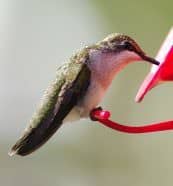
You “macho” outdoor guys may think this a little silly, but I’ll bet you’ve never held a hummingbird in your hand. It inspired compassion; I’ve been setting out hummingbird feeders ever since.
There are 320 species of hummingbirds, with the majority of them living in South America. Ruby-throated hummingbirds are the most common species found west of the Rocky Mountains. They’re about 3 inches long and only weigh 1/8 ounce.
Those we see around here, and the one I held in my hand, winter on the east coast of Central America (southern Mexico to Panama). And when they decide to head north (late February), they fly non-stop for about 500 miles across the Gulf of Mexico at speeds up to 60 mph. It’s hard to imagine such a tiny and delicate creature flying that far like a feathered bullet. It is the Mighty Mouse of the winged world.
Naturally, once they reach the Gulf Coast of the U.S., they feed and rest a bit. They work their way up through the Midwest about the middle of April into May.
The males arrive a week or so before the females, and you can guess what happens when the ladies show up. The males show off by flying in U-shaped loops to impresses the females and mate. Then he flies off to find another. They don’t mate for life or behave in any “Disney” sort of way. Despite their diminutive size and fragile appearance, hummingbirds are solitary and aggressive toward each other, as anyone who has observed them squabbling at a feeder can attest.
Are you enjoying this post?
You can be among the first to get the latest info on where to go, what to use and how to use it!
The females build nests 15 to 20 feet above the ground. The nest is hardly more than 1 inch across and usually only 2 inches high, looking more like a natural knot on the top of a limb than a nest. Into it, she deposits two eggs, each the size of a peanut. The hummingbirds hatch within 12 to 14 days, but they grow fast and leave the nest in just another 18 to 20 days.
Everyone knows how hummingbirds hover and dart up and down and sideways with admirable agility and speed. Proportionally, they have the largest wing muscles of any bird, and flap their wings at a blurring 75 times per second. Technically they’re birds, but they’re more like bumblebees on steroids.
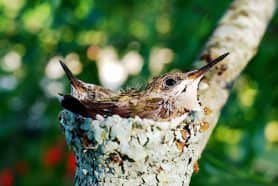
They make their living off nectar, and, like bees, are important for pollinating plants—especially the trumpet creeper. Studies have shown hummingbirds deposit 10 times more pollen in trumpet creepers than bumblebees and honeybees. They are also beneficial to other flowering plants, including columbine and honeysuckle. As natural hummingbird attractions, you can transplant these and other native plants, but they are also attracted to gladiolas, hollyhocks, geraniums and begonias.
What sucks them in most, however, is a hummingbird feeder filled with sugar water. You can buy hummingbird feed, but all you really need is to mix one part table sugar with four parts water. Since most feeders are red, it’s not necessary, nor advisable, to add food coloring to the water.
Bees, wasps and ants can be feeder pests, but the feeders with bee and wasp guards will discourage them, and a little petroleum jelly on the pole and/or string will discourage ants.
Even when you can’t get outdoors, having a hummingbird feeder brings the outdoors to your backyard. I especially like these flitting, fluttering, unique little creatures, but that’s partly because I’ve actually held one in my hand.
Ron Kruger has been communicating the outdoor experience for over four decades. He has worked as a full-time guide for trout on the North Fork, for crappies and bass on Kentucky Lake and for smallmouths on the Current River. He has served as editor of three outdoor magazines, and owns a patent on a fly/lure called the Desperate Diver.
MWO
SHARE THIS POST
You may also like...
Did you enjoy this post?
You can be among the first to get the latest info on where to go, what to use and how to use it!
Ron Kruger
Ron Kruger has been communicating the outdoor experience for more than four decades. He has worked as a full-time guide for trout on the North Fork, for crappies and bass on Kentucky Lake and for smallmouths on the Current River. He has served as editor of three outdoor magazines, and owns a patent on a fly/lure called the Desperate Diver.
